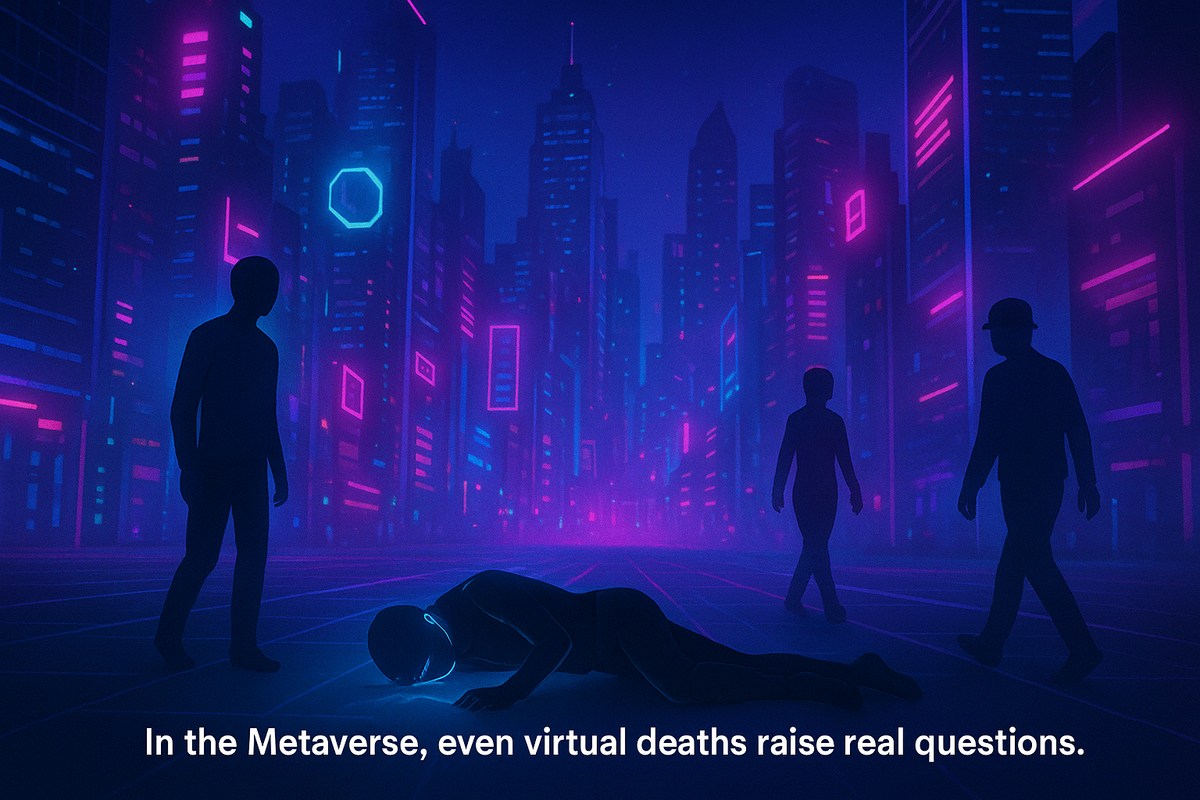Murder on the Metaverse: Can Virtual Killings Lead to Real Charges?
Murder in the Metaverse isn’t legally murder yet. But with VR harassment, stalking, and psychological trauma escalating, the line between digital crime and real justice is vanishing fast

Step into the Metaverse. Avatars walk around in neon cities, VR headsets beam artificial sunsets into your living room, and for a few hours, reality dissolves into code. But what happens when crime follows you inside this digital dimension? More specifically: if someone “kills” your avatar, harasses you in VR, or stalks you across platforms can the real-world justice system intervene?
Welcome to the crime frontier no law book prepared us for.
A Murder That Isn’t a Murder?
Picture this: you’re in a VR gaming lounge, role-playing in a world that looks like Blade Runner meets Fortnite. Out of nowhere, another player attacks your avatar, shoots, and your digital self collapses. No blood. No body. But your heart races as if you just survived an ambush.
Is that just “gameplay,” or has a line been crossed?
Some argue that it’s nothing more than digital pixels interacting. Others insist that psychological trauma is real, even if the crime happens in a simulated world. If someone destroys your carefully built digital property, stalks your avatar, or assaults you in VR, the experience can leave scars almost as damaging as an offline encounter.
This is where the question of virtual crime bleeding into real punishment begins.
Harassment in the Headset
Metaverse harassment isn’t just about a troll spamming insults in chat. Imagine standing in a virtual bar, when another avatar corners yours, blocks your way, and unleashes graphic, unwanted behavior. The physicality of VR with haptic gloves, body tracking, and 360-degree immersion makes it terrifyingly intimate.
Victims of VR harassment describe it as feeling trapped inside someone else’s nightmare. Unlike a mean tweet you can scroll past, VR harassment surrounds you. The attacker is in your space, breathing down your neck in real time.

The legal issue? Consent doesn’t vanish just because the environment is digital. If someone gropes your avatar in VR, is that “harmless fun,” or a form of assault?
When Stalking Goes Digital
Stalking laws were written for the physical world: someone follows you home, leaves notes, or repeatedly appears at your workplace. But what if the stalker shows up every time you log in?
They pop up in your VR office. They teleport next to you in a virtual park. They leave threatening voice messages in your digital mailbox.
The chilling part? Your harasser may never live in the same country, or even continent. Yet the emotional impact is identical to real-world stalking: you feel watched, unsafe, violated.
Suddenly, the idea of “virtual crime” doesn’t sound so virtual anymore.

The Metaverse Black Market
We’re already seeing shady corners of the Metaverse: underground VR clubs, illegal gambling hubs, and markets selling stolen NFT assets. But the darker side goes further. Some worlds allow avatars to “buy” weapons, sell digital drugs, or even pay for simulated acts that echo real-world crimes.
Here’s the kicker: law enforcement agencies are struggling to define what counts as a prosecutable offense. If a hacker steals your rare VR skin worth $50,000 in crypto, courts might call it theft. If your avatar is assaulted in a graphic simulation, prosecutors hesitatethere’s no body, no physical crime scene.
The question isn’t whether crimes are happening. It’s whether the real-world law has the courage to acknowledge them.
Virtual Murder: Psychological Damage vs Legal Vacuum
A “murder” in the Metaverse doesn’t leave you six feet under. But it can still trigger a profound sense of violation. Your avatar is often a digital extension of yourself sometimes closer to your idealized identity than your real body. When it’s destroyed, violated, or permanently banned, it feels personal.
Think about online gaming rage, magnified 1,000 times by immersive VR. If someone repeatedly “kills” your avatar in a non-consensual way, you might laugh it off. But when paired with harassment, doxxing, or threats, it quickly transforms into a campaign of digital terrorism.
Lawyers are already asking: Should intent and trauma outweigh physicality in defining crime?
The Law Is Behind Way Behind
Most criminal codes were written long before VR was even possible. Murder requires a corpse. Theft requires tangible property. Harassment requires physical stalking or communications.
So what happens when crimes evolve faster than lawmakers? You get a Wild West: a lawless space where corporations write their own rules, and users rely on “terms of service” instead of real-world rights.
Today, if someone harasses you in the Metaverse, the most likely response is:
- File a report to the platform
- Hope the account gets suspended
- Maybe just maybe the harasser gets banned
That’s not justice. That’s digital babysitting.
Corporations as the New Police
Here’s the uncomfortable truth: tech companies own the Metaverse. Meta, Roblox, Fortnite, VRChat they control the servers, the spaces, the rules. That means they also act as judge, jury, and executioner.
Ban an account? Easy. Trace an IP? Maybe. But prosecute a user for assault in VR? That’s where corporations shrug and pass the buck to governments that have no framework.
This power vacuum is dangerous. It means the rules of crime and punishment are written by private corporations whose main interest is profit, not justice.
Could Courts Ever Charge “Virtual Murder”?
Let’s push the envelope. Suppose someone creates a VR environment that simulates a murder scenario against another person’s avatar. They carry out a graphic act designed to traumatize. The victim leaves the headset shaken, perhaps suffering PTSD.
Is that free expression or a criminal offense?
Legal experts could argue:
- Prosecution path: Intent to cause psychological harm + demonstrable trauma = assault or harassment charges.
- Defense path: No physical body, no harm. Just “pixels on a screen.”
But courts have already accepted cyberbullying, online threats, and revenge porn as real crimes. Extending this logic, virtual assault or even simulated murder might one day be treated the same way.
The Slippery Slope
Of course, the counterargument is chilling: where do we draw the line? If killing an avatar is “murder,” is blowing up a friend’s base in Minecraft a felony? If scamming a VR casino is “fraud,” is griefing in a game a crime?
The Metaverse thrives on play, chaos, and imagination. Over-regulation risks strangling creativity. Under-regulation risks normalizing abuse. Society is now balancing on a digital razor’s edge.
A Future Courtroom Scenario
Picture a courtroom in 2030:
- A lawyer presents a VR recording where one avatar repeatedly harasses another.
- The jury watches as the victim’s avatar is pinned down, verbally assaulted, and mocked.
- The victim testifies about panic attacks, sleepless nights, and therapy bills.
The defendant shrugs: “It was just a game.”
The jury is left to decide: is this cruelty with consequences, or just role-play gone too far?
That’s the future we’re racing toward, whether we like it or not.

Final Word: Murder in Code, Trauma in Flesh
The Metaverse promised escape, but it has also built a mirror that reflects the ugliest parts of human behavior. Murder in VR isn’t murder in law. Not yet. But the psychological scars are very real, and societies will soon have to decide whether to treat digital crimes with the same seriousness as their physical counterparts.
For now, the Metaverse remains a lawless frontier, where harassment is brushed off as “just pixels,” stalking is dismissed as “just role-play,” and digital murder is laughed off as “just a game.”
But ask the victims, and you’ll hear a different story: the violence in code becomes violence in flesh.
So the question isn’t if the courts will catch up. The question is: how many digital crimes will we ignore before someone demands justice that matters?
Sources:
- CourtListener – Public records and legal opinions database on cybercrime and harassment cases.
👉 https://www.courtlistener.com/ - Justia – Legal information on cyberstalking, harassment, and digital crime statutes.
👉 https://www.justia.com/ - Archive.org (Wayback Machine) – Tracking early reporting on VR crime, digital harassment, and Metaverse law debates.
👉 https://archive.org/ - Google Trends – Data on search trends for “VR harassment,” “Metaverse crime,” “digital stalking,” etc.
👉 https://trends.google.com/




